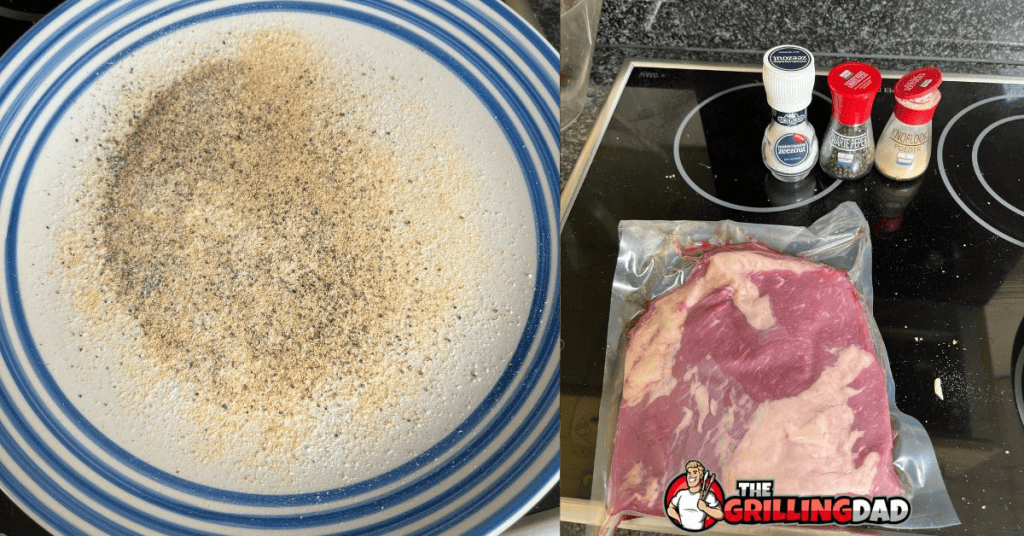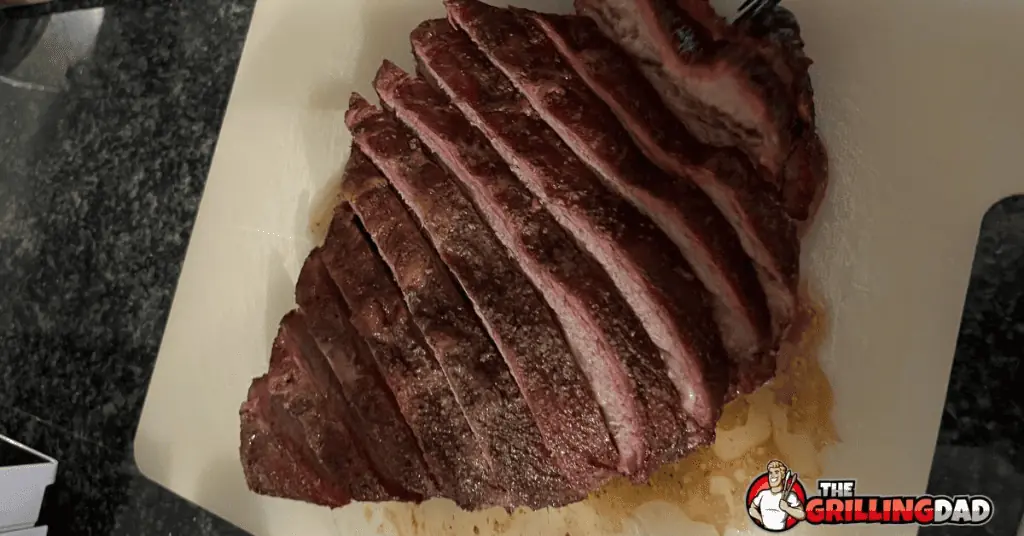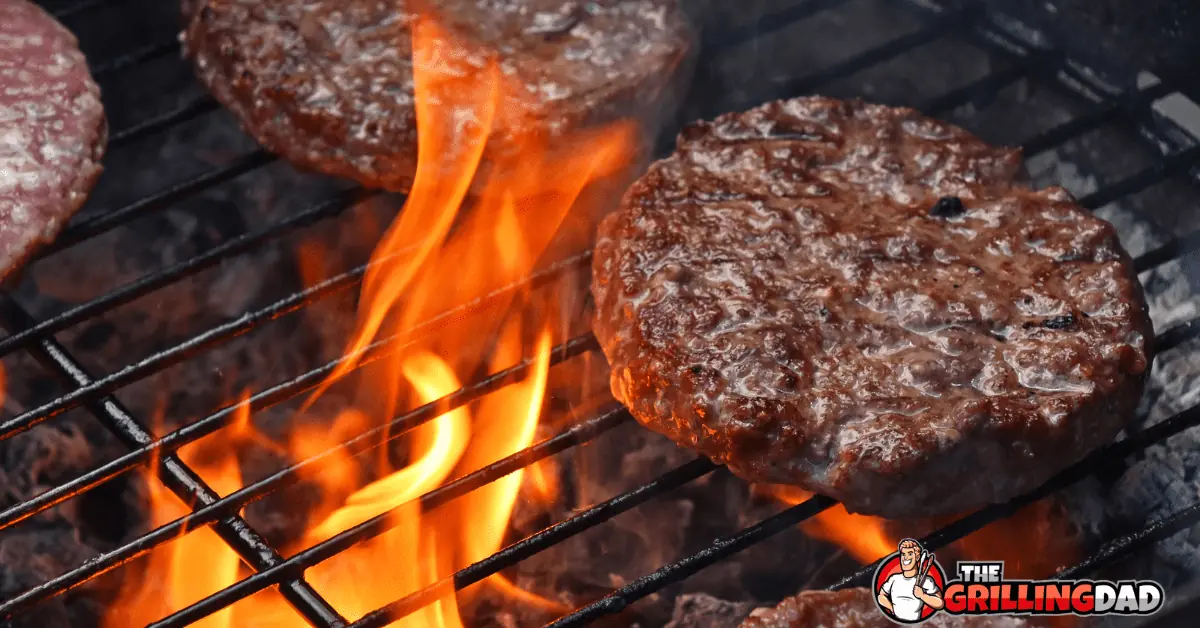The GrillingDad Answer: We’ve done our research and have discovered that cooking with the fat side down offers protection to the meat from the heat source and can lead to a more tender and juicy final product. Here, we always cook our brisket fat side down.
One of the biggest debates among barbecue enthusiasts is whether to cook the brisket with the fat side up or down. Both methods have their pros and cons, with each claiming that their preferred technique results in the most flavorful and tender brisket.
Confused? Don’t worry, we were too. We’ve broken down both the pros and cons for you so you can make the best decision for your brisket. Let’s take a look!

Jump to Section
Brisket Basics
When it comes to cooking a perfect brisket, the debate over whether to smoke or cook it fat side up or down has long been a topic of discussion.
Fat Cap Overview
The fat cap is a layer of fat on one side of the brisket. Brisket is a tough cut of meat, and the fat cap plays a crucial role in keeping the meat moist and tender during the long cooking process.
It is essential to leave some fat on the brisket since it also contributes to the marbling, and adding flavor and juiciness to the meat while it cooks. However, when cooking with indirect heat, such as in a smoker, the position of the fat cap can play a significant role in the final outcome.
Trimming the Fat Cap
Before you can decide on the cooking position, it is important to trim the fat cap. A properly trimmed fat cap will help you achieve the ideal balance between flavor, tenderness, and moisture. The goal is to remove the excess fat without compromising the protection it offers to the brisket.
To trim a brisket, start by placing it on a clean work surface with the fat side up. Hold the knife parallel to the brisket and slice along the length of the fat cap, taking care not to cut too deep into the meat.
As you work, gather the fat in the hand that isn’t holding the knife, tugging to release it from the brisket. The ideal thickness for the remaining fat cap is about 1/4 inch, ensuring that there’s enough fat to protect the meat without rendering too much during the cooking process.
Related >> Chopped or Sliced Brisket: Which is Best for Your BBQ?
At What Temperature Does the Fat Cap Breakdown?
Brisket is a notoriously chewy cut of meat when not cooked properly. In fact, we believe the only way to eat brisket is when it is cooked low and slow. This is because, while beef is technically safe to eat at 155°F, the fat in brisket doesn’t start to break down until 160°F.
This means, you need to cook your brisket to a temperature far beyone 160°F to get the fat to breakdown and go into the meat.
Related >> How Big is a Brisket? A Guide on Meat Cut Size
Connective Tissue Breakdown Temperature
If you’re thinking you’ll pull your brisket off the smoker at 165°F, don’t do it. This is because brisket will remain tough unless the connective tissue in the meat is also allowed to break down.
Connective tissue in brisket breaks down at about 170°F, but it takes a little time to do so. This means you should let the meat stay at this temperature, and even rise above this temperature, for a significant amount of time before pulling it out of the smoker or oven.
We’ve found that brisket is best cooked to at least 190°F to allow both the fat and connective tissue a significant amount of time to break down.

Fat Side Up Vs Fat Side Down Debate
After you have removed the excess fat, it’s time to season your brisket and put it on the grill. But before you do, you need to decide whether to place the brisket fat side up or down.
Advantages of Fat Side Up
Cooking a brisket with the fat side up has some benefits. One of the main reasons for this approach is that the melting fat will pour over and through the brisket, keeping it moist during the cooking process.
Although meat is not a sponge, it will absorb moisture in small amounts as long as the meat is cooked for a long time at a low temperature.
Related >> Where to Probe a Brisket?
Advantages of Fat Side Down
On the other hand, cooking brisket with the fat side down is the preferred method among many experts. In this position, the fat cap acts as a barrier between the heat source and the meat itself, leading to a tender and juicy finished product .
This method can also help protect the spice rub applied to the brisket before cooking, allowing the flavors to penetrate the meat better . Furthermore, even a 1/4 inch of fat will be enough to provide a small barrier that can help prevent the meat from burning and drying out.
The Great Debate
Personal preference plays a significant role in this decision, therefore, it’s essential to consider factors present in your home when you choose, such as the type of smoker you own, heat distribution, and the desired final texture of the brisket.
While this debate will probably never truly be settled, here at TheGrillingDad, we cook our brisket fat side down.
Related >> Lean vs Moist Brisket: A Comparison for BBQ Lovers
Cooking Considerations for Brisket
There are several factors to consider when deciding whether to cook a brisket fat side up or down. These factors include heat source and smoker type, bark formation, and your experience as a smoker.
Heat Source and Smoker Type
The type of smoker or grill and the heat source are crucial in determining the position of the brisket. If you’re using a smoker with direct heat beneath the meat, placing the brisket fat side down will help protect the meat from scorching. If you’re using an offset smoker, you can keep the fat side up, but make sure to rotate the brisket regularly to ensure even cooking.
For charcoal smokers, placing the brisket fat side down may create more smoke, which will enhance the flavor of your meat.
Bark Formation
A well-formed bark is an essential aspect of a perfectly smoked brisket. Cooking the brisket fat side down allows for better bark formation on the meat side, as it is exposed to the radiant heat and smoke in the grill.
Additionally, cooking fat side down prevents the melting fat from washing away the seasoning on the meat, allowing the bark to retain all the flavors you’ve added.
Moisture Retention
One of the goals when cooking a brisket is to retain as much moisture as possible to yield a juicy and tender final product. While some people believe that placing the fat side up allows the melting fat to add moisture to the meat, it’s debatable whether the fat actually penetrates the muscle fibers or if it just goes to the bottom of the smoker
If you’re using an offset smoker, keeping the fat side up could benefit moisture retention. However, when employing other smoker types, doing so may not have a significant impact on the overall moisture content.
Wondering how long to smoke your brisket? We’ve got the full guide here!
Tip for Brisket Seasoning and Flavor Enhancement
When it comes time to season the brisket, there are several methods to consider.
Use Spice Rubs
Spice rubs are a critical aspect of achieving a flavorful brisket. Applying a well-balanced spice rub to both sides of the brisket, including the fat layer, aids in moisture retention and flavor enhancement. The fat can hold a lot of moisture, and it’s essential to season the fat side as it renders during the cooking process.
It’s beneficial to use two layers of seasoning: a base layer, which can be as simple as just salt and pepper, and a secondary layer with your preferred blend of spices and herbs. This double layering technique helps to retain the flavor throughout the barbequing or smoking procedure.
Brining a Brisket
Brining is another method to infuse flavor and ensure a tender final product. A brine is a mixture of water, salt, and various herbs or spices. Soaking the brisket in a brine solution for several hours, or even up to a day before smoking, allows the meat to absorb the added flavors while the salt helps to break down tough connective tissues.
Brisket Basting and Mopping
Basting and mopping are techniques used during the cooking process to keep the brisket moist and enhance its flavor. Basting typically involves applying a liquid, such as a mixture of oil and spice-infused water or a mild vinegar, to the surface of the meat with a basting brush.
Mopping is similar to basting, but utilizes a mop-like tool to apply a thin sauce or mop solution to the brisket. This technique is particularly useful in the smoking process, as it can help maintain moisture and add layers of flavor with each application.
Whichever technique you choose to employ on your brisket, remember that the ultimate goal is to create a tender, flavorful final product. Experimenting with different seasoning methods, spice rub combinations, and basting or mopping solutions will allow you to find the perfect balance of flavors to suit your taste buds.
Dealing with the Brisket Stall
As you cook the brisket, you may encounter a period known as the “stall” where the internal temperature of the brisket seems not to increase for an extended period. This stall can be attributed to evaporative cooling, where moisture evaporates from the surface of the meat, cooling it down in the process.
To counteract the stall, pitmasters can use several techniques, such as wrapping the brisket or increasing the heat of the smoker.
Brisket Wrapping Techniques
One common method to deal with the stall is using various brisket wrapping techniques, which can help speed up the cooking process and preserve moisture in the brisket. Here are some popular wrapping methods:
- Aluminum Foil: Wrapping the brisket in aluminum foil, also known as the “Texas crutch,” is a popular choice. Foil traps moisture and steam, keeping the brisket moist and reducing the overall cooking time.
- Parchment Paper: Wrapping brisket in parchment paper, also known as the “butcher paper wrap,” allows for some breathability while preventing direct exposure to heat. This method helps maintain a good bark on the brisket and enhances the smoky flavor.
- No Wrap: Some pitmasters opt for not wrapping the brisket at all. This technique results in a longer cook time but can produce a crispier bark on the brisket’s surface.
Ultimately, the choice of wrapping technique depends on personal preferences and experience. Experimenting with different methods will help you find the perfect approach for your brisket.
Brisket Presentation and Slicing
When presenting brisket, both the positioning of the fat side and the slicing techniques greatly contribute to the overall appearance and enjoyment of the dish.
Attractive Presentation
Having the fat side up or down affects more than just the flavor of your brisket. The placement also plays a role in the presentation. If you cook the brisket with the fat side down, the fat cap will help protect the meat and retain its moisture, resulting in a more attractive appearance when it’s time to serve your guests.
Additionally, the layer of fat will absorb some of the smoke flavor, enhancing the taste and giving it that mouth-watering, smokey aroma.

Brisket Slicing Tips
To achieve a professional and consistent presentation, be sure to use a sharp carving knife when slicing your cooked brisket. Here are some essential tips:
- Place the brisket on a steady cutting board with the fat side up.
- Begin by slicing across the grain of the meat, as this will give you more tender pieces.
- Take your time while cutting and avoid applying excessive pressure, which can cause uneven slices.
- For horizontal smokers such as offset or pellet smokers, consider placing the fat side up to achieve a better, more visually appealing presentation.
By following these tips, you’ll be well on your way to a beautifully presented and flavorful brisket that is sure to impress your guests.
Barbecue Competitions and Expert Opinions on Brisket Smoking
In barbecue competitions, many competitors choose to cook brisket fat side down, as this can result in a better-looking final product for the judges. When cooking at home, however, opinion is divided as to whether brisket should be cooked fat side up or down. Deciding which method to use depends on factors such as personal preference, the type of smoker being used, and desired results.
Some experts believe that cooking fat side down is the better option, particularly if heat is coming from the bottom of the smoker. This way the fat can help protect the meat from drying out, as the fat cap acts as a barrier between the heat source and the delicate meat, reducing surface drying
On the other hand, the idea that cooking brisket fat side up creates natural basting via rendered fat has long been a popular belief. Unfortunately, this theory has not been proven accurate, as the meat does not actually absorb the fat.
However, some professionals who use the fat side up method argue that it can help to create a better Maillard reaction, leading to a desirable crust on the exterior of the meat.
Ultimately, the choice of fat side up or down will come down to your specific circumstances and personal preferences as the pros are divided as well. It may be helpful to experiment with both methods to determine which one yields the most desirable results for your brisket.
What do we do here at TheGrillingDad? We cook our brisket fat side down! Happy Grilling!
Need help making your first brisket? Head over to our Smoked Brisket Recipe for step-by-step instructions for the best brisket!





